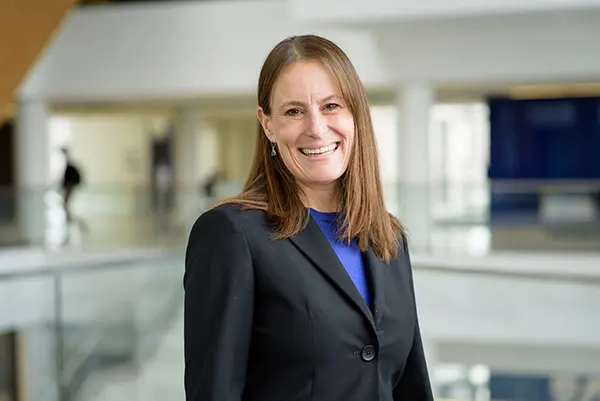Cool Science Uses Youth Art to Educate the Public About Climate Science
 Image by Cool Science
Image by Cool Science
09/16/2021
By Katharine Webster
Education about climate science is key to addressing global warming, because people who understand how human actions affect the climate can make more environmentally friendly decisions and advocate for sustainable policies, says Education Assoc. Prof. Jill Hendrickson Lohmeier.
“When people are educated, they can make green decisions for themselves, their families and their communities,” Lohmeier says.
Lohmeier is a lead researcher for Cool Science, a National Science Foundation (NSF) funded project that studies how children’s art, displayed on city buses, contributes to informal public education about extreme weather and climate science.
Cool Science began as a collaboration between Lohmeier, the late Assoc. Prof. of Education David Lustick, Bob Chen, professor of oceanography and interim dean of UMass Boston’s School for the Environment, and Shanna Thompson, manager of the Center for Program Evaluation in UMass Lowell’s School of Education. It has since expanded to include UML Art Assoc. Prof. Stephen Mishol and faculty at the Massachusetts College of Art and Design, the University of Kansas and Kansas City Art Institute.
Another NSF project, ScienceToGo, used art – posters on MBTA trains and sculptures around Boston – to educate people about rising sea levels. The sculptures, shaped like ostriches, were then repainted and displayed around campus to educate people about sustainability.
Recently, Lohmeier sat down to talk about the role of education in slowing global warming.
Q: With all the extreme weather we’ve experienced recently – wildfires that create firestorms, Category 5 hurricanes, and deadly flash flooding – is there anyone who doesn’t know that climate change is a problem? How can climate education make a difference?
A: People are hungry for knowledge. It’s becoming more apparent that climate change is an important issue, but many people don’t know why it’s happening or what to do.
 Image by Adrien Bisson
Image by Adrien Bisson
Being educated, you can make better decisions for yourself. If you ask yourself every time you make a decision, “What will use the least fossil fuels? Should I drive to the other side of campus or should I walk?” — that has a positive impact.
Education can inform decisions in our communities, too, like here at UMass Lowell when we decide how we build our buildings, how we fuel our campus.
And there is a lot of false information out there, so knowing how to navigate that is important.
Q: What have you learned from your Cool Science research about effective ways to reach people?
A: Our pilot research in Lowell shows that adults engage with the youth art that they see on city buses, that they remember seeing it, that their attitudes are changed after seeing it, and that it makes them interested in learning more about climate science.
That’s because people are attracted to it – it’s fun to see kids’ art. And children and teens make great art. Some of it’s really detailed, some of it’s simple, but it’s all really engaging.
Under the NSF grant, we’ve expanded Cool Science to Worcester, Massachusetts, southern New Hampshire, Kansas and Missouri, to see if our model works in other parts of the country.
Q: How does Cool Science work?
A: Each year, Cool Science holds an art competition for children and teenagers in grades K-12. They learn about climate science, using the resources on our website and elsewhere, to answer one of three questions through a work of art.
We choose winners in different age groups and turn the winning entries into large posters that are displayed on the sides of public buses and smaller posters that are inside the buses. We survey bus riders before and afterward to find out what they’ve noticed and learned.
Afterward, the finalists’ artwork is displayed at a regional celebration, with artists and climate scientists as guest speakers. Under the NSF grant, we’re able to train mentors who work with children and teens in informal settings, such as after-school clubs and programs, scouting programs, church groups, libraries and museums, to help young people prepare for and enter the contest.
Q: How can UML students get educated and involved?
A: A lot of college students work with youth, and if they would like to come to our workshops and mentor the K-12 children and teens that they work with to enter our contest, that would be great. On Coolscience.net, you can find information about the contest and educational resources for all ages.
If you need a research project for a class or you’re looking for experience as a research assistant and you’re interested in our work, please contact us. You can also find lots of other ways to get involved on campus through the Rist Institute for Sustainability and Energy.
To educate yourself, start by looking at the resources from UML’s Climate Change Initiative or on the NOAA (National Oceanographic and Atmospheric Administration) website. One of my favorite books is “Resetting Our Future: What if Solving the Climate Crisis is Simple?” by Tom Bowman. The new U.N. Intergovernmental Panel on Climate Change report just came out, and there are short versions and summaries you can read. (Note: Prof. Mathew Barlow of the Department of Environmental, Earth and Atmospheric Sciences was a lead author on the U.N. report.)
You can use your education to make a difference. Greta Thunberg is one teenager who got really upset about the climate situation, and her impact has been huge, so now there are teens all over the world who are getting together every Friday to protest, and it’s having an impact on policy.




